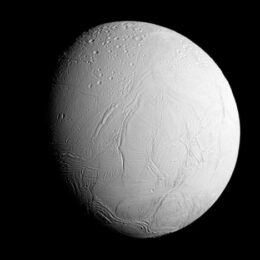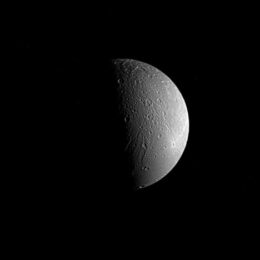Enceladus, one of Saturn’s moons, is currently being tugged around and heated up by another moon named Dione. How the two ended up in this arrangement is a mystery, since to get there, Enceladus must have avoided getting caught up in a resonance with another moon named Tethys. A recent article offers a possible explanation: Enceladus may have blitzed over to its current position in a short-lived burst of speed.

Enceladus, as seen by the Cassini mission in 2015. [NASA/JPL-Caltech/Space Science Institute]
Dynamic Moons
We typically imagine that moons circle their host planets with clockwork regularity, meaning that they precisely trace out the same path at the same speed for all time. However, true reality cannot be described by a system composed of rigid gears. Instead, moons very slowly change their orbits, wandering around to different separations, eccentricities, and inclinations. Through simulations of their motions over millions of years, astronomers can reveal that what initially looks dull and regular is actually just a snapshot of rich, dynamical behaviors.
Predicting these motions is a challenging task since moons are motivated to wander by forces that are difficult to model. Moons are not homogenous, inflexible solid spheres, meaning they can “squish” and “relax” repeatedly as they get tugged around. This squishing, referred to as tidal interactions, saps energy from the moons’ orbits by converting it to heat that warms up the rock and ice of each moon. Describing this behavior relies on knowing quantities that are difficult to measure, such as the composition and interior structure of the planet and each moon.
Obstacle to Dione

An illustration of how Encleadus’s speed affects its response to a resonance. When moving faster (right panel), Enceladus mostly skips over the resonance and remains at a lower inclination compared to the inclination it would have reached had it been moving slower (left panel). Click to enlarge. [Ćuk and El Moutamid 2023]
But how did the pair of moons reach this configuration? By asserting a guess about the parameters that govern the system’s tidal parameters, astronomers can simulate the motion of the moons over millions of years, then check how well their arrangement matches the present day. This was the technique used by Matija Ćuk (SETI Institute) and Maryame El Moutamid (Cornell University) in their recent article that revealed an interesting conclusion: to have reached its current resonance with Dione, Enceladus must have crossed through a region of parameter space where it risked getting trapped into a resonance with a different moon, Tethys.

Dione, whose radius is roughly equal to the distance between Boston and Baltimore. This image was taken with the Cassini spacecraft’s narrow-angle camera on June 22, 2017. [NASA/JPL-Caltech/Space Science Institute]
Spurt of Speed
The fact that we see Enceladus in a low-inclination resonance with Dione today implies that it must have blitzed through this other resonance, drifting so quickly that it managed to skate through unaffected. It could not have kept up this speed for long, however, otherwise it would have been swallowed by Saturn by now. Instead, Ćuk and El Moutamid posit that Enceladus must have experienced a short-lived burst of tidal evolution, a time in which it managed to hop over a resonance with Tethys only to get stuck in one with Dione.
Exactly what caused this burst is unclear, as are the effects of complicated resonances with the fluid interior of Saturn itself. Even so, just by knowing this burst happened, astronomers can another chapter to add to the complex history of this fascinating, watery moon.
Citation
“A Past Episode of Rapid Tidal Evolution of Enceladus?” Matija Ćuk and Maryame El Moutamid 2023 Planet. Sci. J. 4 119. doi:10.3847/PSJ/acde80
